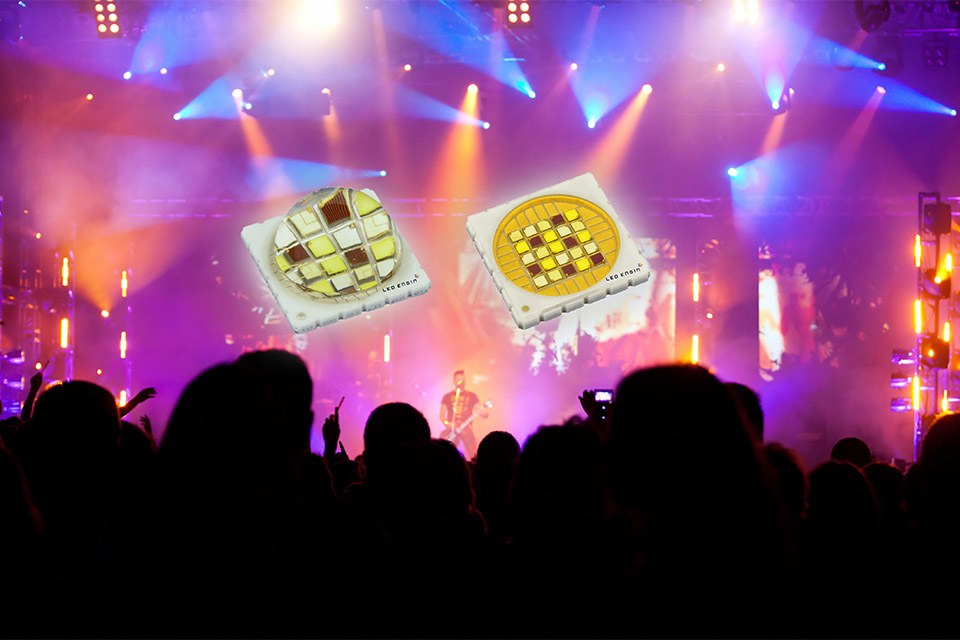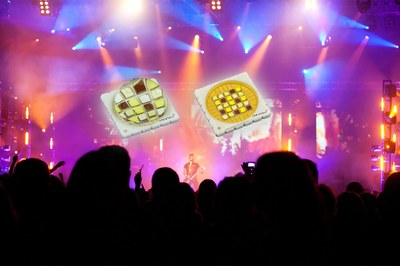New Highest Flux Density RGBW Emitters from LED Engin for Stage and Architectural Lighting
LED Engin, Inc. announces a new world record in both flux and power density for high power, multi-color LED lighting with its latest LZP family of red, green, blue and cool white (RGBW) emitters. The 25-die, 80-watt emitters deliver 3800 lumens, the world’s highest luminous flux density from a 6.2mm x 6.2mm light emitting area on 12mm x 12mm emitter footprint. This has been achieved through an improved LZP package design that results in the industry’s lowest thermal resistance per package footprint of 0.5 °C/watt. As a result, the LZP now gives designers of entertainment and architectural lighting the freedom to create more powerful yet slimmer, very compact lamps in innovative new styles that appeal to customers. The emitter is the first of three new multi-color products in LED Engin’s development schedule announced in April. The others are the LZ7 7-color emitter and the ultra-high power LZ4 4-die RGBW, which can be driven up to 3 amps/die.
The LZP series is available in two versions, featuring either a domed or flat glass primary lens for different applications. The LZP-00MD00 with its glass dome lens is typically used with a total internal reflection (TIR) secondary lens to deliver high flux output. It’s a popular choice for architectural lighting, including wall-wash fixtures and accent and effect lighting. The flat lens of the LZP-04MD00 is particularly suited to punchy stage and studio lighting where beams of less than 10 degrees are often required. Its compact étendue facilitates the use of zoom optics, mixing rods, light pipes or other optics to produce narrow beams.
Using only three of the new LZP emitters, illumination equivalent to that from a typical 10,000 lumen (approximately 700 watt) HID bulb used in profile lamp can be achieved. Light absorbing color filters are not needed, so efficiency is greatly improved. With 25 mixed-color dies arranged closely, the LZP series simplifies board and circuit design. It also enables a more compact fixture footprint than that of competing single-die or 4-die LEDs. What’s more, fewer secondary optical components are required, helping reduce the bill of materials and simplifying attachment of the optics.
LED Engin offers a full suite of total internal reflection (TIR) optics suitable for use with the LZP emitters, offering a wide range of output patterns from 13 to 47 degrees, which help designers create high-performing and unique solutions to lighting challenges. Zoom optics and optics for beams narrower than 10 degrees are available from a third-party supplier in December.
David Tahmassebi, LED Engin’s CEO and President, said, “These new emitters once again demonstrate LED Engin’s technical innovation and leadership. We’re dedicated to developing LED products that enable lighting designers to express their creativity and produce better products for their customers, particularly in the competitive and highly demanding entertainment lighting sector.”
The LZP-00MD00 and LZP-04MD00 are available now from LED Engin and its distributors. The company is also sampling the LZ7 and ultra high power LZ4 RGBW. Further details of these products will be released when they are available in volume.
For additional information, you may download the LZP-00MD00 Datasheet and the LZP-04MD00 Datasheet
To find a sales representative, please visit www.LEDEngin.com
About LED Engin, Inc:
LED Engin, based in California’s Silicon Valley, specializes in ultra-bright, ultra-compact solid state lighting solutions that allow designers and engineers the freedom to create uncompromised yet energy efficient lighting experiences. The company’s LuxiGen™ Platform - an emitter and lens combination or integrated module, delivers superior flexibility in light output, ranging from 3W to 90W, a wide spectrum of available colors, including whites, multi-color and UV, and the ability to deliver upwards of 5,000 high quality lumens to a target. The small size combined with powerful output allows for a previously unobtainable freedom of design wherever high flux density, directional light is required.


